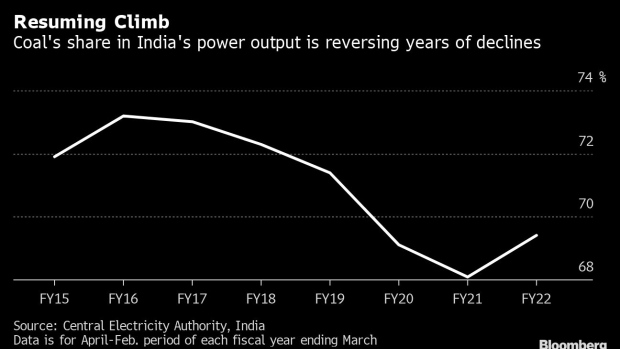Mar 9, 2022
Coal’s Comeback in India Shows Scale of Climate Challenge
, Bloomberg News

(Bloomberg) -- Coal’s share in India’s power mix rose after five years of declines, underscoring Prime Minister Narendra Modi’s challenge to overhaul the nation’s energy sector and meet climate goals.
The fuel contributed 69% of the country’s total electricity generation in the first 11 months of the fiscal year to March, compared with about 68% a year earlier, Bloomberg calculations based on data from the Central Electricity Authority show. Power output from the fuel was at a record during the 11-month period, rising more than 10% over the year.
With international energy prices surging amid Russia’s invasion of Ukraine and the rupee recovering from a record low, the government is under pressure to produce more coal domestically. Key coal markets have hit record highs with buyers from Asia to Europe wary of taking cargoes from Russia, the world’s third-biggest exporter of the fuel.
“When the power demand is strong, India will have to continue depending on coal for several years,” said Debasish Mishra, a Mumbai-based partner at Deloitte Touche Tohmatsu. “We are likely to see an acceleration in domestic production in the near-term, although in the long-term such price shocks strengthen the case for a clean-energy transition.”
High seaborne prices have also affected generation at coastal power plants that rely on imported coal, adding to demand for domestic supplies.
India, the world’s third-biggest emitter of greenhouse gases, plans to zero out emissions by 2070. To reach that goal, the country plans to build 500 gigawatts of clean power capacity by 2030 and reduce the emissions intensity of the economy by 45% from 2005 levels.
While setting these more ambitious transition goals at the COP26 climate summit in Glasgow last year, the nation joined neighbor China in resisting global action to phase out coal and had the language diluted to a “phase-down.” The country has argued that a knee-jerk exit from coal could deprive millions of its citizens of access to affordable energy.
India’s renewable power market has grown more than threefold over the past eight years to 106 gigawatts, accounting for more than a quarter of the country’s installed generation capacity. Other sources of clean electricity, such as hydropower and nuclear, have been slow to catch up, ensuring coal’s dominance.
©2022 Bloomberg L.P.





